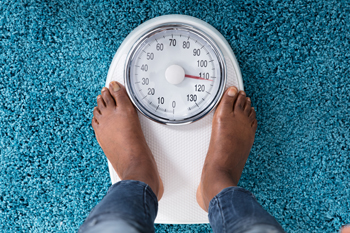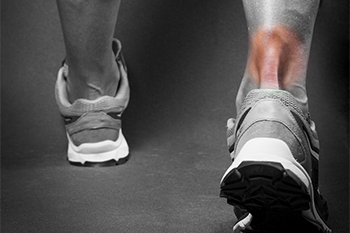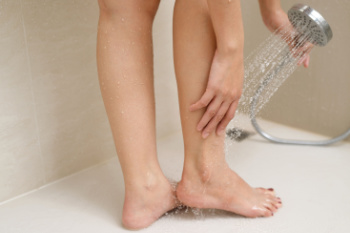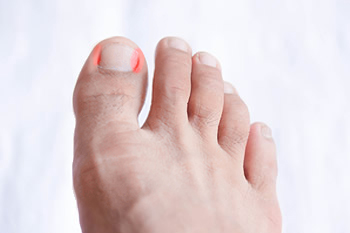Connect With Us
Blog
Items filtered by date: March 2024
Excess Weight and Circulatory Issues of the Feet

Poor circulation in the feet refers to reduced blood flow to the lower extremities, leading to symptoms like cold feet, numbness, tingling, and slow wound healing. It occurs when blood vessels become narrowed or blocked, restricting the flow of oxygen-rich blood to the feet. Typical causes of poor circulation include peripheral artery disease, atherosclerosis, diabetes, smoking, high blood pressure, and high cholesterol levels. Obesity can exacerbate poor circulation in the feet due to several factors. Excess body weight increases the workload on the heart and blood vessels, leading to conditions like hypertension and atherosclerosis. Fat accumulation around blood vessels can also compress them, further impairing blood flow. Managing poor circulation involves lifestyle changes like regular exercise, maintaining a healthy weight, quitting smoking, and controlling underlying medical conditions. In severe cases, medical interventions like medications or surgical procedures may be necessary to improve blood flow. If you have symptoms of poor circulation in your feet, it is suggested that you schedule an appointment with a podiatrist for a proper diagnosis and treatment.
Obesity has become very problematic at this point in time and can have extremely negative effects on the feet. If you’re an obese individual and are concerned about your feet, contact one of our podiatrists from Garnet & Carbonell, DPM, LLC. Our doctors can provide the care you need to keep you pain-free and on your feet.
Obesity and Your Feet
Since your feet are what support your entire weight when standing, any additional weight can result in pain and swelling. Being overweight is one of the main contributors to foot complications.
Problems & Complications
Extra Weight – Even putting on just a few extra pounds could create serious complications for your feet. As your weight increases, your balance and body will shift, creating new stresses on your feet. This uneven weight distribution can cause pain, even while doing the simplest tasks, such as walking.
Diabetes – People who are overweight are at serious risk of developing type-2 diabetes, which has a drastic impact on the health of your feet. As you get older, your diabetes might worsen, which could lead to loss of feeling in your feet, sores, and bruises. You could also become more prone to various infections.
Plantar fasciitis – Pressure and stress that is placed on muscles, joints, and tendons can trigger plantar fasciitis, which is an inflammation of tissue that forms along the bottom of the foot.
If you have any questions please feel free to contact our offices located in Palmetto Bay, South Miami, and Homestead, FL . We offer the newest diagnostic and treatment technologies for all your foot and ankle needs.
Causes and Symptoms of Achilles Tendonitis

Achilles tendonitis, an inflammation of the Achilles tendon, disrupts the smooth functioning of the tendon connecting the calf muscles to the heel bone. Contributing factors include tight calf muscles and excessive running up and down hills. Sudden increases in exercise intensity or duration of activity and wearing improper footwear, such as stiff-soled shoes or high heels, are other causes of Achilles tendonitis. Athletes engaging in activities that involve repetitive jumping or sudden stops or starts are particularly prone to overuse injuries like Achilles tendonitis. The main symptom is pain along the tendon, especially near the heel. Other signs of Achilles tendonitis can include swelling, warmth, and tenderness over the affected area. Difficulty rising on the toes or pushing off while walking, in addition to morning heel pain accompanied by ankle stiffness are further indicators. Recovery for Achilles tendonitis typically includes anti-inflammatory medication, rehabilitation exercises, and use of walking boots or casts for immobilization. If you are experiencing symptoms of Achilles tendonitis, it is suggested that you schedule an appointment with a podiatrist for an exam, diagnosis, and personalized treatment.
Achilles tendon injuries need immediate attention to avoid future complications. If you have any concerns, contact one of our podiatrists of Garnet & Carbonell, DPM, LLC. Our doctors can provide the care you need to keep you pain-free and on your feet.
What Is the Achilles Tendon?
The Achilles tendon is a tendon that connects the lower leg muscles and calf to the heel of the foot. It is the strongest tendon in the human body and is essential for making movement possible. Because this tendon is such an integral part of the body, any injuries to it can create immense difficulties and should immediately be presented to a doctor.
What Are the Symptoms of an Achilles Tendon Injury?
There are various types of injuries that can affect the Achilles tendon. The two most common injuries are Achilles tendinitis and ruptures of the tendon.
Achilles Tendinitis Symptoms
- Inflammation
- Dull to severe pain
- Increased blood flow to the tendon
- Thickening of the tendon
Rupture Symptoms
- Extreme pain and swelling in the foot
- Total immobility
Treatment and Prevention
Achilles tendon injuries are diagnosed by a thorough physical evaluation, which can include an MRI. Treatment involves rest, physical therapy, and in some cases, surgery. However, various preventative measures can be taken to avoid these injuries, such as:
- Thorough stretching of the tendon before and after exercise
- Strengthening exercises like calf raises, squats, leg curls, leg extensions, leg raises, lunges, and leg presses
If you have any questions please feel free to contact our offices located in Palmetto Bay, South Miami, and Homestead, FL . We offer the newest diagnostic tools and technology to treat your foot and ankle needs.
Plantar Warts Can Be Treated!
The Well-Being of Your Feet

Taking care of your feet is essential for overall well-being, given that the average person takes between 8,000 to 10,000 steps per day. Daily foot care helps to prevent injuries and alleviate discomfort in the feet, knees, hips, and back. Wearing appropriate shoes tailored to specific activities will ensure adequate support. When purchasing new footwear, factors such as cushioning, arch support, and shock absorption should be prioritized. Regularly inspecting shoes for wear and tear is also important, as worn-out shoes can contribute to foot problems. Additionally, it's advisable to minimize walking barefoot on hard surfaces to avoid inflammation. Pedicures can be beneficial for foot maintenance, provided personal tools are used to reduce the risk of infections. Incorporating stretching exercises and regular foot massages into your routine can further enhance foot health and overall well-being. By following these practices, you can improve comfort, productivity, and quality of life, one step at a time. If foot or ankle issues occur from time to time, it is suggested that you make an appointment with a podiatrist to have your feet examined, a proper diagnosis made, and appropriate treatment administered.
Everyday foot care is very important to prevent infection and other foot ailments. If you need your feet checked, contact one of our podiatrists from Garnet & Carbonell, DPM, LLC. Our doctors can provide the care you need to keep you pain-free and on your feet.
Everyday Foot Care
Often, people take care of their bodies, face and hair more so than they do for their feet. But the feet are a very important aspect of our bodies, and one that we should pay more attention to. Without our feet, we would not be able to perform most daily tasks.
It is best to check your feet regularly to make sure there are no new bruises or cuts that you may not have noticed before. For dry feet, moisturizer can easily be a remedy and can be applied as often as necessary to the affected areas. Wearing shoes that fit well can also help you maintain good foot health, as well as making it easier to walk and do daily activities without the stress or pain of ill-fitting shoes, high heels, or even flip flops. Wearing clean socks with closed shoes is important to ensure that sweat and bacteria do not accumulate within the shoe. Clean socks help to prevent Athlete’s foot, fungi problems, bad odors, and can absorb sweat.
If you have any questions, please feel free to contact our offices located in Palmetto Bay, South Miami, and Homestead, FL . We offer the newest diagnostic and treatment technologies for all your foot care needs.
Treatment for Ingrown Toenails

An ingrown toenail happens when the nail's edges grow into the adjacent skin, causing pain and possible infection. Typically affecting the big toe, an ingrown toenail presents with swelling, redness, and potential infection. Home treatment is possible, but severe pain or spreading requires professional attention to avoid complications. Consultation with a podiatrist is vital, especially for those individuals with conditions such as diabetes or poor circulation. Over-the-counter remedies only mask pain, they do not solve the issue. Surgery may be necessary if symptoms persist, with options including partial or total nail avulsion under local anesthesia. After surgery, proper care is essential to prevent infection, and antibiotics may be prescribed if infection occurs. If you have an ingrown toenail, it is suggested that you schedule an appointment with a podiatrist to get treatment underway immediately.
Ingrown toenails can become painful if they are not treated properly. For more information about ingrown toenails, contact one of our podiatrists of Garnet & Carbonell, DPM, LLC. Our doctors can provide the care you need to keep you pain-free and on your feet.
Ingrown Toenails
Ingrown toenails occur when a toenail grows sideways into the bed of the nail, causing pain, swelling, and possibly infection.
Causes
- Bacterial infections
- Improper nail cutting such as cutting it too short or not straight across
- Trauma to the toe, such as stubbing, which causes the nail to grow back irregularly
- Ill-fitting shoes that bunch the toes too close together
- Genetic predisposition
Prevention
Because ingrown toenails are not something found outside of shoe-wearing cultures, going barefoot as often as possible will decrease the likeliness of developing ingrown toenails. Wearing proper fitting shoes and using proper cutting techniques will also help decrease your risk of developing ingrown toenails.
Treatment
Ingrown toenails are a very treatable foot condition. In minor cases, soaking the affected area in salt or antibacterial soaps will not only help with the ingrown nail itself, but also help prevent any infections from occurring. In more severe cases, surgery is an option. In either case, speaking to your podiatrist about this condition will help you get a better understanding of specific treatment options that are right for you.
If you have any questions please feel free to contact our offices located in Palmetto Bay, South Miami, and Homestead, FL . We offer the newest diagnostic and treatment technologies for all your foot and ankle needs.

